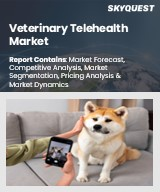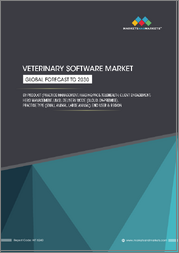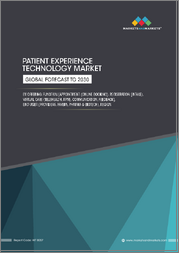
|
시장보고서
상품코드
1587788
미국의 원격의료 시장 규모, 점유율, 동향 분석 보고서 : 제품별, 제공 모드별, 최종 용도별, 질병 영역별, 부문별 예측(2025-2030년)U.S. Telehealth Market Size, Share & Trends Analysis Report By Product (Hardware, Software, Services), By Delivery Mode (On-premises), By End Use (Payers, Providers), By Disease Area, And Segment Forecasts, 2025 - 2030 |
||||||
미국의 원격의료 시장 성장과 동향
Grand View Research, Inc.의 새로운 보고서에 따르면, 미국의 원격의료 시장 규모는 2030년까지 1,501억 3,000만 달러에 달할 것으로 예상됩니다.
2025-2030년 연평균 23.8%의 성장률을 기록할 것으로 예상됩니다. 미국의 원격의료 산업의 성장에는 디지털 의료 서비스 채택 증가, 양호한 소비자 기반, 대규모 투자 등 몇 가지 주요 요인이 기여하고 있습니다. 또한, 원격 환자 모니터링에 대한 수요 증가와 의료 서비스를 향상시키는 디지털 통신 기술의 발전은 향후 몇 년 동안 시장 성장을 촉진할 것으로 예상됩니다. 미국 내 의사 및 임상의 부족도 원격의료 산업 확장의 원동력이 될 것으로 예상됩니다.
예를 들어, 미국 의과대학 협회가 2021년 6월에 발표한 보고서에 따르면, 2034년까지 전문 의료와 일차 의료를 포함해 37,800-124,000명의 의사가 부족할 것으로 예측하고 있습니다. 또한, COVID-19 팬데믹 기간 동안 미국에서 시행된 사회적 거리두기 조치로 인해 원격 환자 방문을 위한 디지털 의료 플랫폼의 사용이 증가했으며, 이러한 변화는 시장 확대에 큰 기여를 하고 있습니다. 예를 들어, 미국 질병통제예방센터(CDC)는 2020년 3월 한 달 동안 미국 내 원격진료가 전년도, 특히 2019년 3월에 비해 154% 증가했다고 보고했습니다.
이러한 원격 디지털 의료 서비스는 환자와 의료진 모두에게 질병에 노출될 위험을 줄임으로써 유익하다는 것이 입증되고 있습니다. 또한, 미국인들의 인터넷 접근성이 높아지고 컴퓨터, 태블릿, 스마트폰 등의 기기 보급이 증가함에 따라 산업 성장의 잠재적 기회가 창출되고 있습니다. 원격의료는 환자와 의료 시스템 모두에게 잠재적인 비용 절감 효과를 가져다 줍니다. 원격의료는 대면 진료의 필요성과 여행비, 시설 이용료 등 관련 비용을 줄임으로써 전체 의료비 지출을 줄일 수 있습니다. 예를 들어, 시그나(Cigna)의 2022년 1월 보고서에 따르면, 가상 진료는 의료비에서 1회 방문당 약 100달러의 비용 절감 효과가 있는 것으로 나타났습니다.
또한, 최근 JAMA Network Open에 게재된 논문은 원격의료 서비스가 비고령자 암 환자의 시간과 여행 비용을 줄이는 데 중요한 역할을 한 것으로 나타났다고 밝혔습니다. 이 조사에 따르면, 원격의료를 통해 147.4달러에서 186.1달러의 비용을 절감할 수 있었다고 보고했습니다. 또한, 원격의료는 대기 시간 단축, 예약 일정 최적화, 관리 프로세스 간소화를 통해 효율성을 높일 수 있습니다. 또한 미국에서는 환자와 의사가 실시간으로 소통할 수 있는 원격 환자 모니터링 서비스에 대한 수요가 증가하고 있습니다. 이러한 서비스는 더욱 지능적이고 비용 효율적이며 임상 결과를 개선하는 데 도움이 되고 있습니다.
그 결과, 원격의료 서비스 제공업체들은 이 시장에 대한 투자를 늘리는 추세입니다. 이러한 의료 혁명에 발맞추기 위해 미국 의료 기관들은 IT 인프라, 하드웨어, 소프트웨어, 사물인터넷(IoT) 기능, 확장 가능한 설계, 데이터 관리, 환자 보안 등 6가지 핵심 구성요소에 대한 인프라를 빠르게 업그레이드하고 있습니다. 보안입니다. 예를 들어, 2021년 6월 퍼시스턴트시스템즈는 IBM과 협력하여 디지털 혁신을 강화하고, 핵심 IT 시설을 현대화하며, 고객용 하이브리드 클라우드 플랫폼을 최적화하기 위해 투자했습니다.
미국의 원격의료 시장 보고서 하이라이트
- 서비스 부문은 2024년 47.4%로 가장 큰 매출 비중을 차지했습니다. 만성질환 관리, 실시간 모니터링, 디지털 인프라, 인터넷 접근성, 스마트폰 사용의 지속적인 발전, 원격의료 애플리케이션에 대한 수요 증가가 이 부문의 성장에 기여하고 있습니다.
- 웹 기반 부문은 2024년 45.9%의 가장 큰 매출 점유율을 차지했습니다. 이 부문의 성장을 촉진하는 요인은 지방의 의료 품질을 향상시키기 위해 모바일 헬스 커뮤니케이션 및 원격 환자 모니터링에 웹 기반 전달 방법의 사용이 증가하고 있기 때문입니다.
- 정신의료 부문은 2024년 12.4%의 매출 점유율로 시장을 장악하고 예측 기간 동안 가장 빠른 속도로 성장할 것으로 예상됩니다.
- 공급자 부문은 2024년 52.6%의 매출 점유율로 시장을 장악했습니다. 이러한 성장은 의료 시설의 부담을 줄이기 위해 의료 전문가들 사이에서 원격의료, 원격진료 및 원격의료의 채택이 증가하고 있기 때문입니다.
목차
제1장 조사 방법과 범위
제2장 주요 요약
제3장 미국의 원격의료 시장 변수, 동향, 범위
- 시장 계통 전망
- 상부 시장 전망
- 보조 시장 전망
- 시장 역학
- 시장 성장 촉진요인 분석
- 시장 성장 억제요인 분석
- 미국의 원격의료 : 시장 분석 툴
- 산업 분석 - Porter's Five Forces 분석
- PESTLE 분석
제4장 미국의 원격의료 시장 부문 분석, 제품별, 2018-2030년(100만 달러)
- 정의와 범위
- 제품 시장 점유율 분석, 2024년과 2030년
- 부문 대시보드
- 미국의 원격의료 시장, 제품별, 2018-2030년
- 하드웨어
- 하드웨어 시장 추정과 예측, 2018-2030년
- 모니터
- 의료 주변기기
- 소프트웨어
- 소프트웨어 시장 추정과 예측, 2018-2030년
- 독립형 소프트웨어
- 통합 소프트웨어
- 서비스
- 2018-2030년 서비스 시장 추정과 예측
- 원격 환자 모니터링
- 실시간 인터랙션
- 저장 후 전달
- 기타
제5장 미국의 원격의료 시장 부문 분석, 제공 모드별, 2018-2030년(100만 달러)
- 정의와 범위
- 제공 모드 시장 점유율 분석, 2024년과 2030년
- 부문 대시보드
- 미국의 원격의료 시장, 제공 모드별, 2018-2030년
- 온프레미스
- 온프레미스 시장 추정과 예측, 2018-2030년
- 웹 기반
- 웹 기반 시장 추정과 예측, 2018-2030년
- 클라우드 기반
- 클라우드 기반 시장 추정과 예측, 2018-2030년
제6장 미국의 원격의료 시장 부문 분석, 질환 영역별, 2018-2030년(100만 달러)
- 정의와 범위
- 질환 영역 시장 점유율 분석, 2024년과 2030년
- 부문 대시보드
- 미국의 원격의료 시장, 질환 영역별, 2018-2030년
- 정신 의료
- 정신 의료 시장 추정과 예측, 2018-2030년
- 약제 사용
- 약제 사용 시장 추정과 예측, 2018-2030년
- 방사선과
- 방사선과 시장 추정과 예측, 2018-2030년
- 내분비학
- 내분비학 시장 추정과 예측, 2018-2030년
- 소화기내과
- 소화기내과 시장 추정과 예측, 2018-2030년
- 피부과
- 피부과 시장 추정과 예측, 2018-2030년
- 신경내과
- 신경내과 의료 시장 추정과 예측, 2018-2030년
- 이비인후과
- 이비인후과 시장 추정과 예측, 2018-2030년
- 심장병학
- 심장병학 시장 추정과 예측, 2018-2030년
- 종양학
- 종양학 시장 추정과 예측, 2018-2030년
- 치과
- 치과 시장 추정과 예측, 2018-2030년
- 부인과
- 부인과 시장 추정과 예측, 2018-2030년
- 일반 내과
- 일반 내과 시장 추정과 예측, 2018-2030년
- 기타
- 기타 시장 추정과 예측, 2018-2030년
제7장 미국의 원격의료 시장 부문 분석, 최종 용도별, 2018-2030년(100만 달러)
- 정의와 범위
- 최종 용도 시장 점유율 분석, 2024년과 2030년
- 부문 대시보드
- 미국의 원격의료 시장, 최종 용도별, 2018-2030년
- 지불자
- 지불자 시장 추정과 예측, 2018-2030년
- 프로바이더
- 프로바이더 시장 추정과 예측, 2018-2030년
- 환자
- 환자 시장 추정과 예측, 2018-2030년
제8장 경쟁 상황
- 주요 시장 진출 기업의 최근 동향과 영향 분석
- 기업 분류
- 기업 개요
- Koninklijke Philips NV
- GE Healthcare
- Oracle(Cerner Corporation)
- Siemens Healthineers
- Medtronic
- Teladoc Health Inc
- American Well
- MDLIVE
- Doctor on Demand
- GlobalMed
U.S. Telehealth Market Growth & Trends:
The U.S. telehealth market size is expected to reach USD 150.13 billion by 2030, according to a new report by Grand View Research, Inc. It is expected to grow at a CAGR of 23.8% from 2025 to 2030. Several key factors are contributing to the growth of the telehealth industry in the U.S. These include the increasing adoption of digital health services, a favorable consumer base, and significant investment. Furthermore, the growing demand for remote patient monitoring and advancements in digital communication technology that enhances healthcare services are anticipated to fuel market growth in the coming years. The shortage of physicians and clinicians in the U.S. is also expected to be a driving force behind the telehealth industry's expansion.
For instance, a report released by the Association of American Medical Colleges in June 2021 projects a potential deficit of 37,800 to 124,000 physicians by 2034, encompassing both specialty and primary care. Furthermore, the market growth has been propelled by the increased utilization of digital healthcare platforms for remote patient visits, driven by the implementation of social distancing measures during the COVID-19 pandemic in the U.S. This shift has significantly contributed to the expansion of the market. For example, the Centers for Disease Control and Prevention (CDC) reported a substantial 154% increase in telehealth visits in the U.S. during March 2020 compared to the previous year, specifically in March 2019.
These remote digital healthcare services have proven beneficial by reducing disease exposure risks for both patients and healthcare staff. In addition,the growing accessibility of the Internet among the U.S. population and the rising adoption of devices, such as computers, tablets, and smartphones, create potential opportunities for industry growth.Telehealth offers potential cost savings for both patients and healthcare systems. By reducing the need for in-person visits and associated expenses, such as travel costs and facility fees, telehealth can lower overall healthcare expenditures. For instance, according to a January 2022 report by Cigna, virtual care was associated with an approximate cost reduction of $100 per visit in healthcare expenses.
Similarly, a recent publication in JAMA Network Open revealed that telehealth services played a significant role in reducing time and travel expenses for non-elderly individuals with cancer. The study reported cost savings ranging from USD 147.4 to USD 186.1 as a result of utilizing telehealth.Moreover, telehealth can increase efficiency by reducing wait times, optimizing appointment scheduling, and streamlining administrative processes. Furthermore,there is an increasing demand for remote patient monitoring services in the U.S., which enable real-time interactions between patients and physicians. These services have become more intelligent and cost-effective, leading to improved clinical outcomes.
As a result, telehealth providers are inclined to invest more in this market. To keep pace with this healthcare revolution, healthcare organizations in the U.S. are actively transforming their infrastructure. They are rapidly upgrading themselves with six crucial components: IT infrastructures, hardware, software, Internet of Things (IoT) capabilities, scalable design, data management, and patient security. For example, in June 2021, Persistent Systems partnered with and invested in IBM to enhance its digital transformation, modernize core IT facilities, and optimize its hybrid cloud platform for customers.
U.S. Telehealth Market Report Highlights:
- The services segment held the largest revenue share of 47.4% in 2024. The growing demand for telehealth applications in chronic disease management, real-time monitoring, and the continuous advancements in digital infrastructure, internet accessibility, and smartphone usage contribute to this segment's growth.
- The web-based segment held the largest revenue share of 45.9% in 2024. The segment's growth is fueled by the rising use of web-based delivery methods in mobile health communication and remote patient monitoring, which aim to enhance the quality of healthcare in rural regions.
- The psychiatry segment dominated the market with a revenue share of 12.4% in 2024 and is anticipated to grow at the fastest rate over the forecast period.
- The providers segment dominated the market with a revenue share of 52.6% in 2024. The growth is attributed to the growing adoption of telehealth, teleconsultation, and telemedicine among healthcare professionals to reduce the burden on healthcare facilities.
Table of Contents
Chapter 1. Methodology and Scope
- 1.1. Market Segmentation & Scope
- 1.1.1. Segment scope
- 1.1.2. Estimates and forecast timeline
- 1.2. Research Methodology
- 1.3. Information Procurement
- 1.3.1. Purchased database
- 1.3.2. GVR's internal database
- 1.3.3. Secondary sources
- 1.3.4. Primary research
- 1.3.5. Details of primary research
- 1.4. Information or Data Analysis
- 1.4.1. Data analysis models
- 1.5. Market Formulation & Validation
- 1.6. Model Details
- 1.7. Research Assumptions
- 1.8. List of Secondary Sources
- 1.9. List of Primary Sources
Chapter 2. Executive Summary
- 2.1. Market Outlook
- 2.2. Segment Outlook
- 2.2.1. Product outlook
- 2.2.2. Delivery Mode outlook
- 2.2.3. Disease Area outlook
- 2.2.4. End Use outlook
- 2.3. Competitive Insights
Chapter 3. U.S. Telehealth Market Variables, Trends & Scope
- 3.1. Market Lineage Outlook
- 3.1.1. Parent market outlook
- 3.1.2. Ancillary market outlook
- 3.2. Market Dynamics
- 3.2.1. Market driver analysis
- 3.2.2. Market restraint analysis
- 3.3. U.S. Telehealth: Market Analysis Tools
- 3.3.1. Industry Analysis - Porter's
- 3.3.2. PESTLE Analysis
Chapter 4. U.S. Telehealth Market Segment Analysis, By Product, 2018 - 2030 (USD Million)
- 4.1. Definition and Scope
- 4.2. Product Market Share Analysis, 2024 & 2030
- 4.3. Segment Dashboard
- 4.4. U.S. Telehealth Market, by Product, 2018 to 2030
- 4.5. Hardware
- 4.5.1. Hardware market estimates and forecasts 2018 to 2030 (USD Million)
- 4.5.2. Monitors
- 4.5.2.1. Monitors market estimates and forecasts, 2018 - 2030 (USD Million)
- 4.5.3. Medical Peripheral Devices
- 4.5.3.1. Medical Peripheral Devices market estimates and forecasts, 2018 - 2030 (USD Million)
- 4.5.3.2. Blood Pressure Meters
- 4.5.3.2.1. Blood Pressure Meters market estimates and forecasts, 2018 - 2030 (USD Million)
- 4.5.3.3. Blood Glucose Meters
- 4.5.3.3.1. Blood Glucose Meters market estimates and forecasts, 2018 - 2030 (USD Million)
- 4.5.3.4. Weighing Scales
- 4.5.3.4.1. Weighing Scales market estimates and forecasts, 2018 - 2030 (USD Million)
- 4.5.3.5. Pulse Oximeters
- 4.5.3.5.1. Pulse Oximeters market estimates and forecasts, 2018 - 2030 (USD Million)
- 4.5.3.6. Peak Flow Meters
- 4.5.3.6.1. Peak Flow Meters market estimates and forecasts, 2018 - 2030 (USD Million)
- 4.5.3.7. ECG Monitors
- 4.5.3.7.1. ECG Monitors market estimates and forecasts, 2018 - 2030 (USD Million)
- 4.5.3.8. Others
- 4.5.3.8.1. Others market estimates and forecasts, 2018 - 2030 (USD Million)
- 4.6. Software
- 4.6.1. Software market estimates and forecasts 2018 to 2030 (USD Million)
- 4.6.2. Standalone Software
- 4.6.2.1. Standalone Software market estimates and forecasts, 2018 - 2030 (USD Million)
- 4.6.3. Integrated Software
- 4.6.3.1. Integrated Software market estimates and forecasts, 2018 - 2030 (USD Million)
- 4.7. Services
- 4.7.1. Services market estimates and forecasts 2018 to 2030 (USD Million)
- 4.7.2. Remote Patient Monitoring
- 4.7.2.1. Remote Patient Monitoring market estimates and forecasts, 2018 - 2030 (USD Million)
- 4.7.3. Real-Time Interactions
- 4.7.3.1. Real-Time Interactions market estimates and forecasts, 2018 - 2030 (USD Million)
- 4.7.4. Store And Forward
- 4.7.4.1. Store And Forward market estimates and forecasts, 2018 - 2030 (USD Million)
- 4.7.5. Other Services
- 4.7.5.1. Other Services market estimates and forecasts, 2018 - 2030 (USD Million)
Chapter 5. U.S. Telehealth Market Segment Analysis, By Delivery Mode, 2018 - 2030 (USD Million)
- 5.1. Definition and Scope
- 5.2. Delivery Mode Market Share Analysis, 2024 & 2030
- 5.3. Segment Dashboard
- 5.4. U.S. Telehealth Market, by Delivery Mode, 2018 to 2030
- 5.5. On-Premises
- 5.5.1. On-Premises market estimates and forecasts, 2018 to 2030 (USD million)
- 5.6. Web-Based
- 5.6.1. Web-Based market estimates and forecasts, 2018 to 2030 (USD Million)
- 5.7. Cloud-Based
- 5.7.1. Cloud-Based market estimates and forecasts, 2018 to 2030 (USD Million)
Chapter 6. U.S. Telehealth Market Segment Analysis, By Disease Area, 2018 - 2030 (USD Million)
- 6.1. Definition and Scope
- 6.2. Disease Area Market Share Analysis, 2024 & 2030
- 6.3. Segment Dashboard
- 6.4. U.S. Telehealth Market, by Disease Area, 2018 to 2030
- 6.5. Psychiatry
- 6.5.1. Psychiatry market estimates and forecasts 2018 to 2030 (USD Million)
- 6.6. Substance Use
- 6.6.1. Substance Use market estimates and forecasts 2018 to 2030 (USD Million)
- 6.7. Radiology
- 6.7.1. Radiology market estimates and forecasts, 2018 - 2030 (USD Million)
- 6.8. Endocrinology
- 6.8.1. Endocrinology market estimates and forecasts, 2018 - 2030 (USD Million)
- 6.9. Gastroenterology
- 6.9.1. Gastroenterology market estimates and forecasts, 2018 - 2030 (USD Million)
- 6.10. Dermatology
- 6.10.1. Dermatology market estimates and forecasts, 2018 - 2030 (USD Million)
- 6.11. Neurological Medicine
- 6.11.1. Neurological Medicine market estimates and forecasts, 2018 - 2030 (USD Million)
- 6.12. ENT
- 6.12.1. ENT market estimates and forecasts, 2018 - 2030 (USD Million)
- 6.13. Cardiology
- 6.13.1. Cardiology market estimates and forecasts, 2018 - 2030 (USD Million)
- 6.14. Oncology
- 6.14.1. Oncology market estimates and forecasts, 2018 - 2030 (USD Million)
- 6.15. Dental
- 6.15.1. Dental market estimates and forecasts, 2018 - 2030 (USD Million)
- 6.16. Gynecology
- 6.16.1. Gynecology market estimates and forecasts, 2018 - 2030 (USD Million)
- 6.17. General Medicine
- 6.17.1. General Medicine market estimates and forecasts, 2018 - 2030 (USD Million)
- 6.18. Others
- 6.18.1. Others market estimates and forecasts, 2018 - 2030 (USD Million)
Chapter 7. U.S. Telehealth Market Segment Analysis, By End Use, 2018 - 2030 (USD Million)
- 7.1. Definition and Scope
- 7.2. End Use Market Share Analysis, 2024 & 2030
- 7.3. Segment Dashboard
- 7.4. U.S. Telehealth Market, by End Use, 2018 to 2030
- 7.5. Payers
- 7.5.1. Payers market estimates and forecasts 2018 to 2030 (USD Million)
- 7.6. Providers
- 7.6.1. Providers market estimates and forecasts 2018 to 2030 (USD Million)
- 7.7. Patients
- 7.7.1. Patients market estimates and forecasts 2018 to 2030 (USD Million)
Chapter 8. Competitive Landscape
- 8.1. Recent Developments & Impact Analysis, By Key Market Participants
- 8.2. Company Categorization
- 8.3. Company Profiles
- 8.3.1. Koninklijke Philips N.V.
- 8.3.1.1. Company overview
- 8.3.1.2. Financial performance
- 8.3.1.3. Product benchmarking
- 8.3.1.4. Strategic initiatives
- 8.3.2. GE Healthcare
- 8.3.2.1. Company overview
- 8.3.2.2. Financial performance
- 8.3.2.3. Product benchmarking
- 8.3.2.4. Strategic initiatives
- 8.3.3. Oracle (Cerner Corporation)
- 8.3.3.1. Company overview
- 8.3.3.2. Financial performance
- 8.3.3.3. Product benchmarking
- 8.3.3.4. Strategic initiatives
- 8.3.4. Siemens Healthineers
- 8.3.4.1. Company overview
- 8.3.4.2. Financial performance
- 8.3.4.3. Product benchmarking
- 8.3.4.4. Strategic initiatives
- 8.3.5. Medtronic
- 8.3.5.1. Company overview
- 8.3.5.2. Financial performance
- 8.3.5.3. Product benchmarking
- 8.3.5.4. Strategic initiatives
- 8.3.6. Teladoc Health Inc
- 8.3.6.1. Company overview
- 8.3.6.2. Financial performance
- 8.3.6.3. Product benchmarking
- 8.3.6.4. Strategic initiatives
- 8.3.7. American Well
- 8.3.7.1. Company overview
- 8.3.7.2. Financial performance
- 8.3.7.3. Product benchmarking
- 8.3.7.4. Strategic initiatives
- 8.3.8. MDLIVE
- 8.3.8.1. Company overview
- 8.3.8.2. Financial performance
- 8.3.8.3. Product benchmarking
- 8.3.8.4. Strategic initiatives
- 8.3.9. Doctor on Demand
- 8.3.9.1. Company overview
- 8.3.9.2. Financial performance
- 8.3.9.3. Product benchmarking
- 8.3.9.4. Strategic initiatives
- 8.3.10. GlobalMed
- 8.3.10.1. Company overview
- 8.3.10.2. Financial performance
- 8.3.10.3. Product benchmarking
- 8.3.10.4. Strategic initiatives
- 8.3.1. Koninklijke Philips N.V.
(주말 및 공휴일 제외)


















